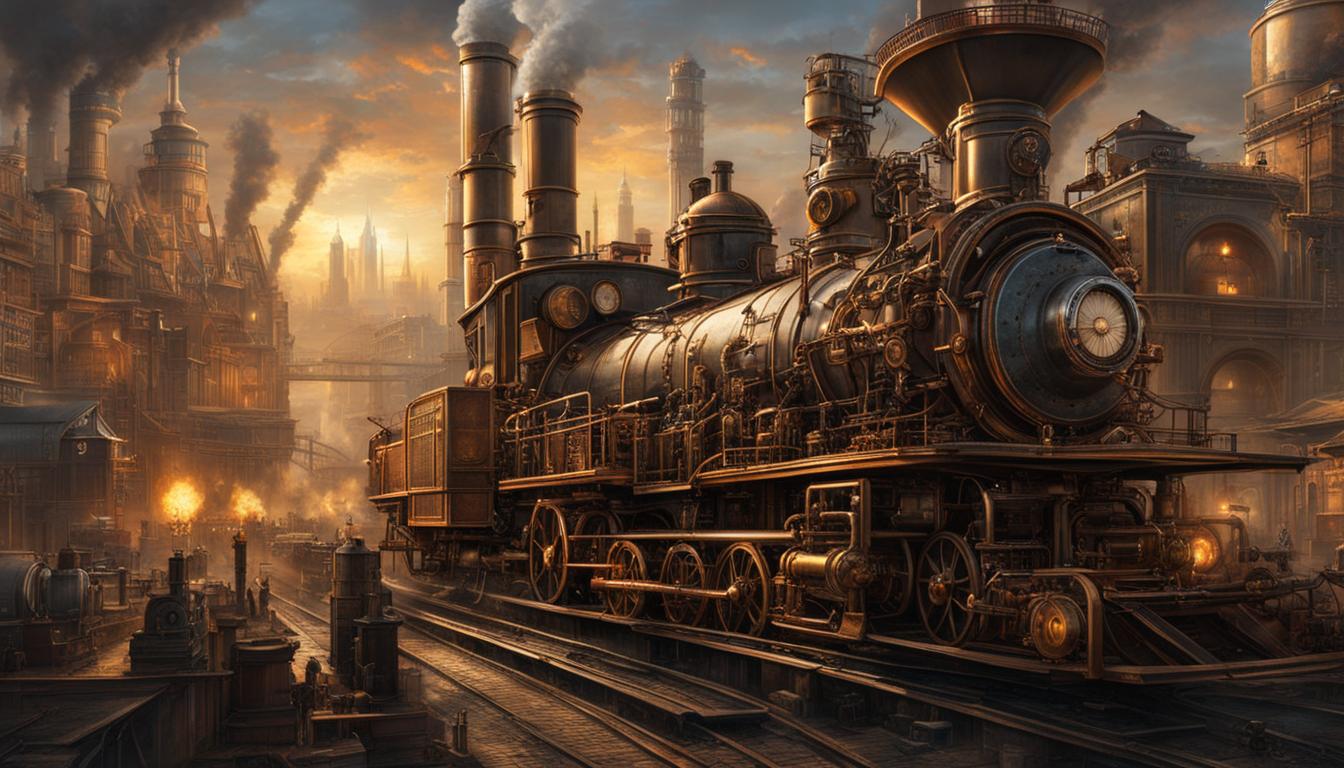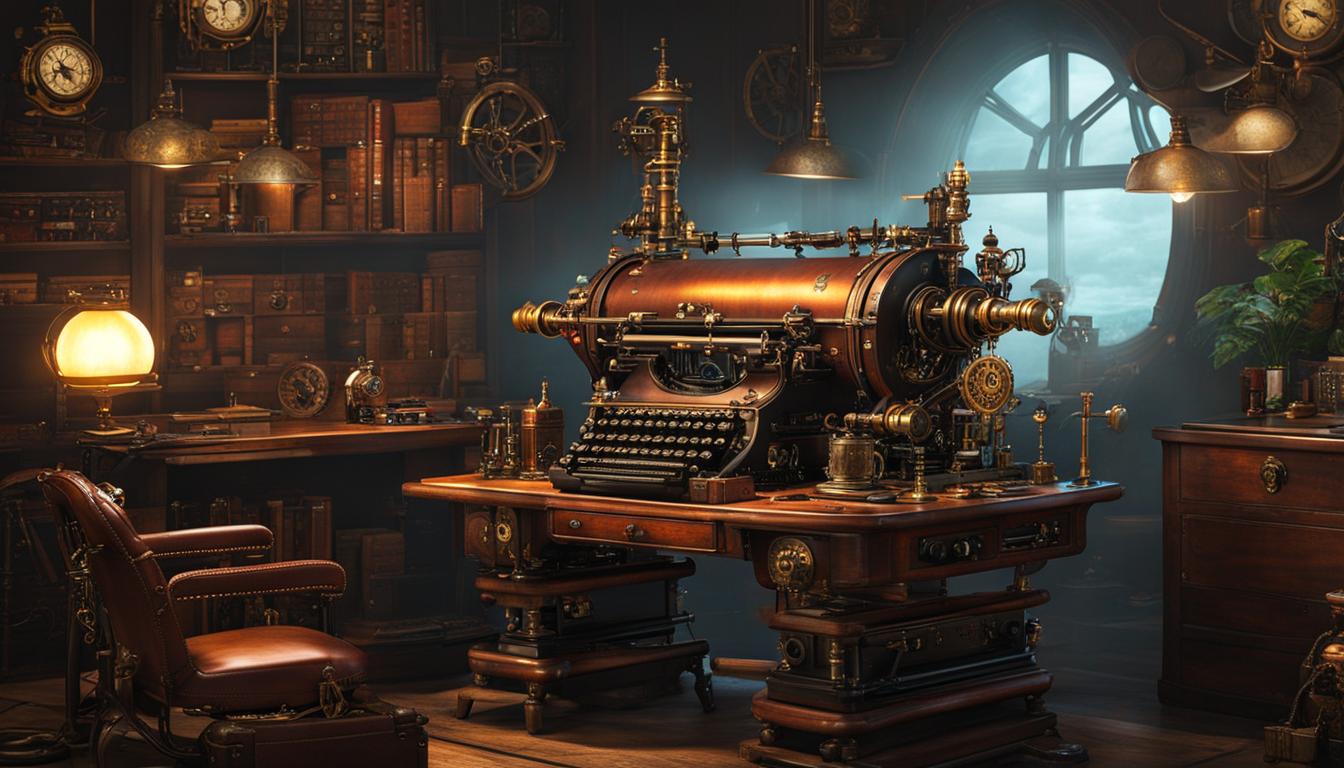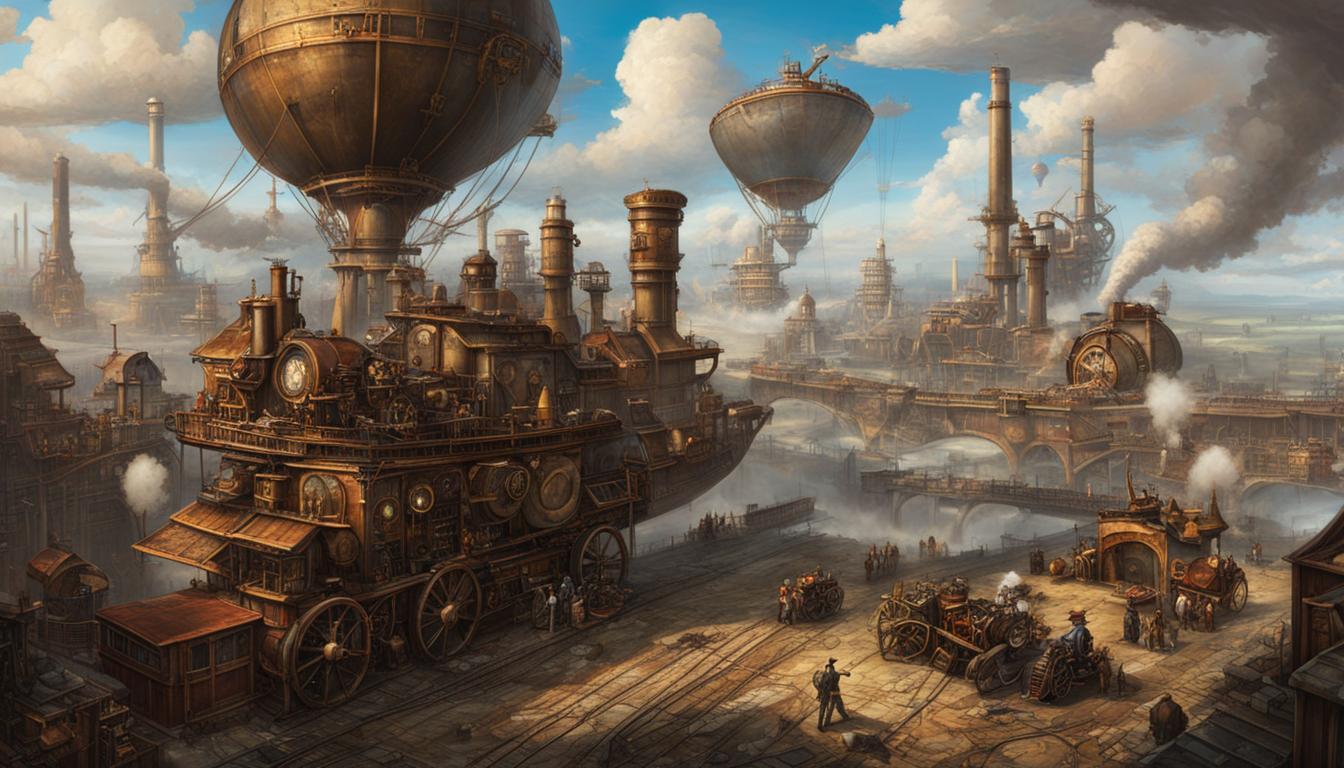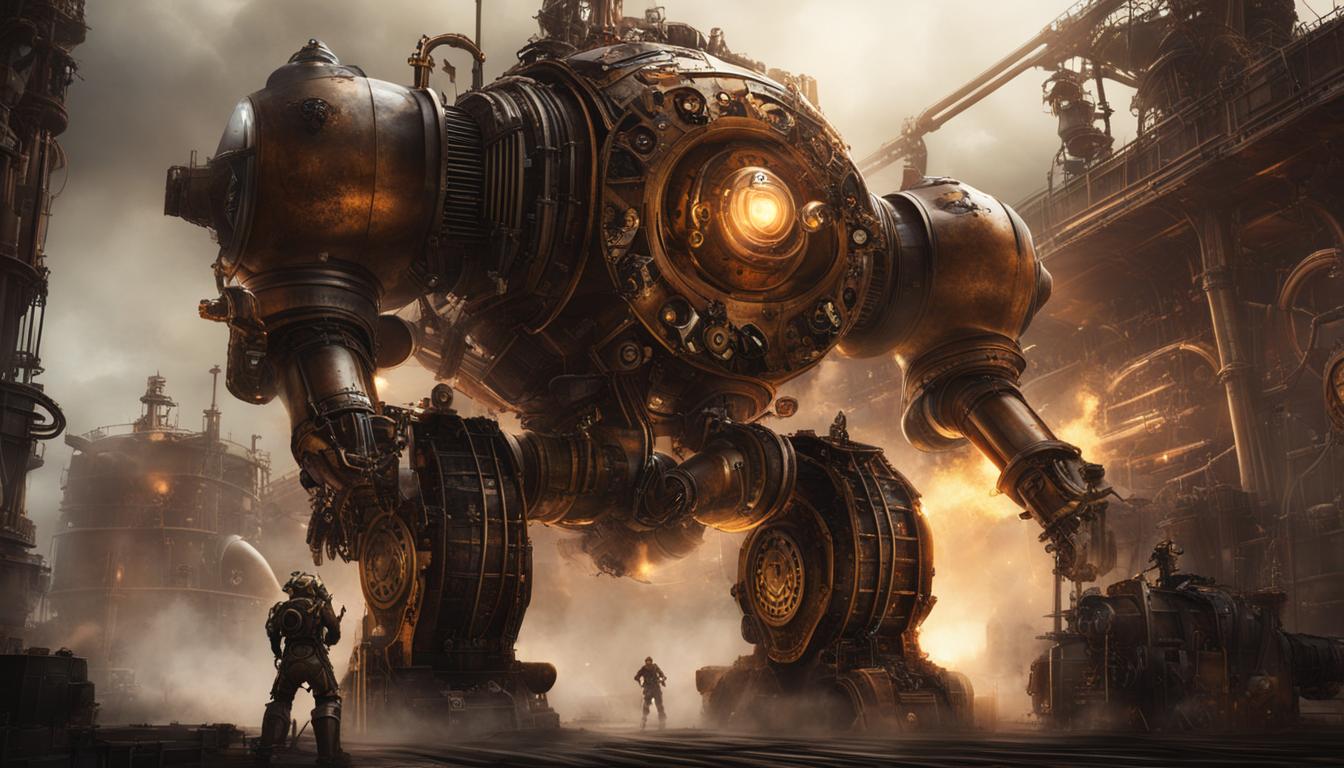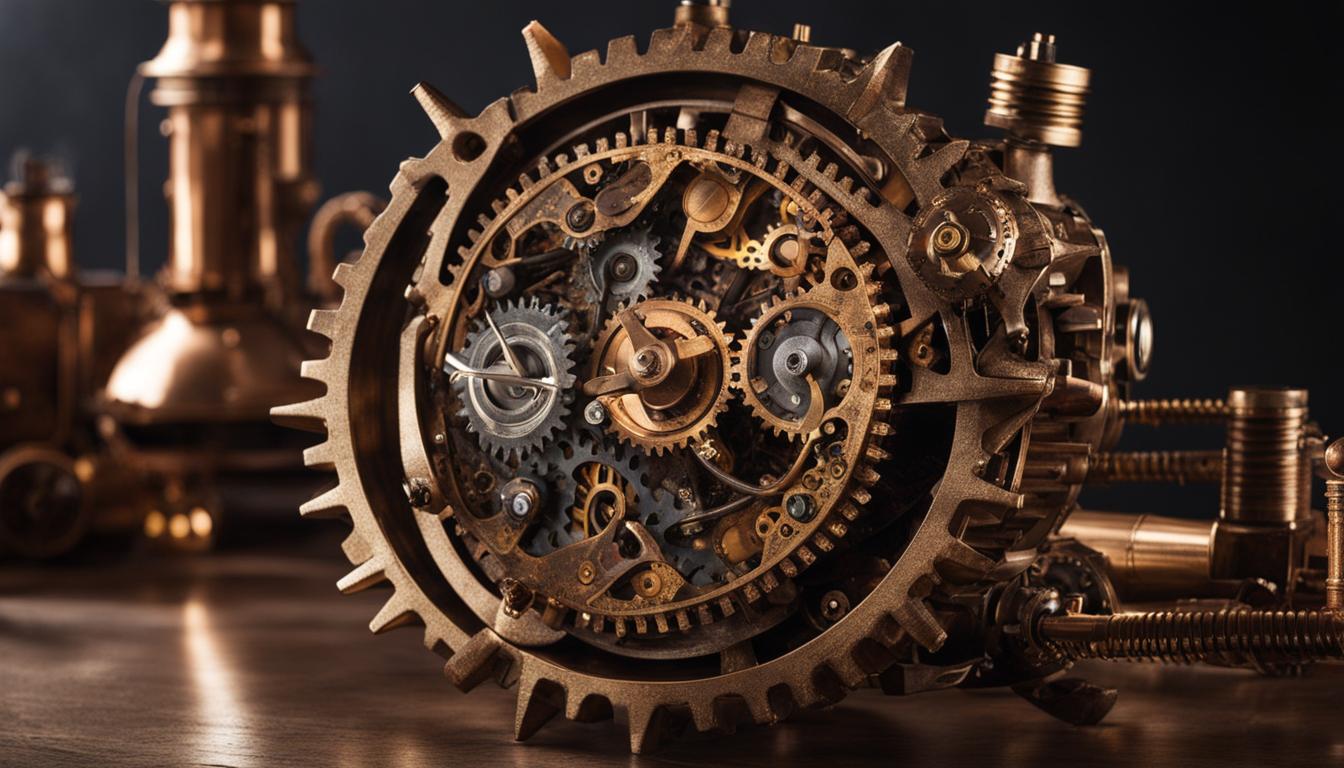Steampunk is more than just a visual aesthetic. It is a philosophy for life that encompasses principles of self-sufficiency, creativity, support for local business, and respect for craftsmanship. This philosophy finds its roots in the Arts and Crafts Movement of the Victorian era, which was a response to the Industrial Revolution. Steampunk enthusiasts value function, design, and romantic execution of objects in their lives. The steampunk philosophy can be summarized by William Morris’ quote, “Have nothing in your houses that you do not know to be useful, or believe to be beautiful.”
Key Takeaways:
- Steampunk is a philosophy for life, encompassing self-sufficiency, creativity, and respect for craftsmanship.
- It originated from the Arts and Crafts Movement of the Victorian era, in response to the Industrial Revolution.
- Steampunk emphasizes the value of functional and beautifully designed objects.
- William Morris’ quote captures the essence of steampunk philosophy: “Have nothing in your houses that you do not know to be useful, or believe to be beautiful.”
- Understanding the scientific principles behind steampunk concepts allows for a deeper appreciation of the genre.
The Retro Element of Steampunk
In the world of steampunk, the retro element reigns supreme. This subgenre of science fiction is set in the steam age, a time after the industrial revolution but before the widespread use of combustion engines. The technology of this era is steam-powered, and it forms the basis for the imaginative machines and inventions commonly found in steampunk works.
Steampunk allows for the exploration of alternative technologies and anachronistic creations that could have existed in the 19th century. It blends elements of fantasy and science fiction, presenting a world where steam-powered robots, airships, analog computers, and other imaginative contraptions exist. The retro element of steampunk gives creators the freedom to reimagine what people in the past might have envisioned for the future.
Steampunk in the context of science is an intriguing concept. It takes inspiration from the scientific advancements of the Victorian era and extrapolates them into fantastical creations. By examining the physics behind steampunk technology, we can appreciate the blend of real-world science with the imaginative possibilities of the genre.
The Physics of Steampunk Technology
To understand the physics of steampunk technology, we need to delve into the principles of thermodynamics and fluid mechanics. Steam engines, the driving force behind steampunk contraptions, rely on the expansion of steam to generate power. They harness the transfer of heat energy and convert it into mechanical work, allowing the steam-powered creations of steampunk to come to life.
Steampunk presents a unique twist on physics by exploring the potential of steam-powered technology in a world where other energy sources like electricity and gasoline are not yet widely utilized. This opens up exciting possibilities for authors and creators, allowing them to imagine alternative power sources and intricate mechanisms that are driven by steam engines.
The Aesthetic Appeal of Steampunk
Steampunk is not just about the technology; it embraces a distinct visual aesthetic as well. The materials used in steampunk designs, such as brass, wood, leather, and stained glass, contribute to its nostalgic and romantic atmosphere. By incorporating natural materials and intricate detailing, steampunk creators transport us back to the craftsmanship and attention to detail of the Victorian era.
The retro element of steampunk, with its blend of imaginative technology and vintage aesthetics, captivates our imaginations and sparks a sense of wonder. It allows us to explore an alternative past where steam-powered machines and fantastical inventions coexist, inviting us to embrace the limitless possibilities of the steam age.
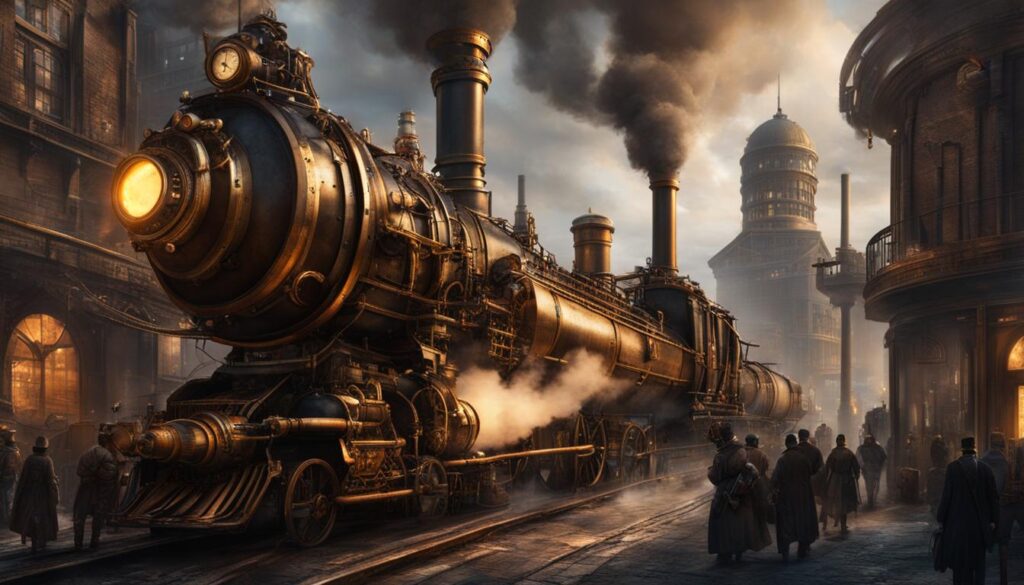
The Fuel and Power Element of Steampunk
In the world of steampunk, the power source that drives the imaginative contraptions is typically steam. Unlike our modern reliance on electricity and gasoline, steampunk creators envision a world where steam engines reign supreme. This choice of power source not only adds to the overall aesthetic and atmosphere of the genre but also introduces exciting possibilities for alternative energy in fictional settings.
Steampunk technology often features intricate machines driven by steam engines, showcasing the ingenuity and creativity of its creators. From steam-powered airships soaring through the skies to steam-driven automata performing intricate tasks, the use of steam as a fuel source allows for the invention of unique and mesmerizing contraptions. The absence of electricity and gasoline in the steampunk world fosters the exploration of alternative power sources, encouraging authors and creators to push the boundaries of scientific concepts within their narratives.
Lighting in the steampunk world is also a departure from modern conventions. Instead of relying on electricity, steampunk settings often use natural oils or carbide lamps to illuminate their surroundings. This attention to detail adds to the immersive experience of the genre, reinforcing the nostalgic ambiance of an era before the widespread adoption of modern lighting technology.

The Steampunk Fuel and Power Table
| Fuel Source | Advantages | Disadvantages |
|---|---|---|
| Steam | Abundant and accessible in steampunk settings | Requires large boilers and infrastructure |
| Natural Oils | Creates a warm and flickering light | Requires regular refilling and maintenance |
| Carbide Lamps | Portable and reliable | Produces a harsh and less natural light |
As seen in the table, steam offers the advantage of being abundant and accessible in steampunk settings. However, it also requires large boilers and infrastructure to harness its power. On the other hand, natural oils create a warm and flickering light, but they require regular refilling and maintenance. Carbide lamps, although portable and reliable, produce a harsh and less natural light compared to other options. These fuel sources and their respective advantages and disadvantages highlight the attention to detail and thoughtfulness behind the steampunk genre’s construction.
The Contraption Element of Steampunk
In the world of steampunk, the contraptions take center stage, adding a touch of wonder and imagination to the stories. These anachronistic inventions are the products of creative minds, blending elements of fantasy and science fiction with the aesthetics of the steam age. From steam-powered robots to airships and holograms, the contraptions in steampunk transport us to a world where technology has taken a different path.
One of the key aspects of steampunk contraptions is the exploration of alternative uses for technology. In a time before the widespread use of combustion engines, writers and creators imagine what could have been possible with steam-powered machines. These contraptions often play significant roles in the narratives, contributing to the saving of the world, the defeat of villains, or the survival of the protagonists. They become integral parts of the story, reflecting the ingenuity and creativity of the characters.
In the steampunk genre, contraptions are not just functional but also visually stunning. They showcase intricate designs, mechanical intricacies, and attention to detail. The use of natural materials like polished wood, brass, and leather adds to their nostalgic and authentic appeal. These contraptions are not simply gadgets; they are works of art that transport us to a world where imagination and science merge.
“Steampunk contraptions are not just machines; they are windows into a world where imagination and science merge.”
The Marvelous Machines of Steampunk
The world of steampunk is filled with an array of marvelous machines that defy expectations and challenge our understanding of what was possible in the steam age. To give you a glimpse of these extraordinary contraptions, here is a list of some of the most iconic examples:
| Contraption | Description |
|---|---|
| Airship | A fantastical flying vessel propelled by steam-powered engines and adorned with elaborate sails and gears. |
| Automaton | A humanoid robot with intricate mechanical workings, often designed to perform tasks or assist humans. |
| Time Machine | A contraption that allows travel through time, bridging the gaps between different eras and dimensions. |
| Tesla Coil Gun | A weapon that harnesses the power of electricity to shoot bolts of lightning at enemies. |
| Submarine | A steam-powered vessel capable of exploring the depths of the ocean, equipped with advanced navigation and life support systems. |
These are just a few examples of the incredible variety of contraptions that can be found in the world of steampunk. Each one adds a touch of whimsy and excitement, captivating readers and viewers with their innovative designs and unexpected functionalities.
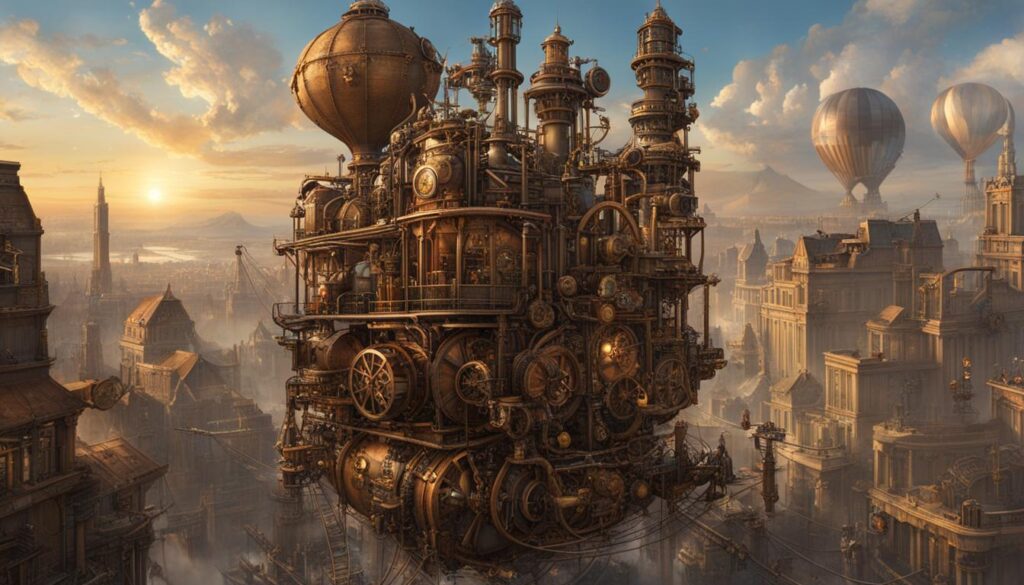
The contraption element of steampunk is a fundamental component of the genre. It highlights the ingenuity, creativity, and limitless possibilities of the steam age. By exploring the scientific concepts behind these fictional contraptions, we can gain a deeper appreciation for the melding of science and imagination that defines steampunk.
The Materials Element of Steampunk
In the world of steampunk, the materials used play a crucial role in creating its distinctive aesthetic and ambiance. A blend of vintage charm and intricate detailing, steampunk relies heavily on natural elements to bring its creations to life.

Polished wood, brass filigree, leather, and stained glass are among the commonly used materials in steampunk art and design. These materials evoke a sense of nostalgia, capturing the essence of the Victorian era. By avoiding modern materials like plastic and focusing on craftsmanship, steampunk creators foster an atmosphere that showcases attention to detail and a passion for the art form.
The use of these natural materials not only adds authenticity to steampunk creations but also highlights the genre’s commitment to a bygone era. It is through the careful selection and manipulation of these materials that steampunk artists are able to transport us to a world fueled by imagination and the romance of the past.
The Romance Element of Steampunk
Beyond the visual and technological elements, steampunk also captures a sense of romance and nostalgia for a simpler time. The genre often portrays a world of manners and etiquette, where heroic individuals maintain their gentlemanly demeanor and feisty women embody femininity even in challenging situations. This romantic element adds depth to the stories and allows readers and viewers to escape into an alternative past that offers a mix of adventure, imagination, and old-fashioned values.
Steampunk embraces the ideals of chivalry and courtship, with protagonists engaging in epic love stories against a backdrop of steam-powered machinery and ornate Victorian settings. These stories often feature forbidden love, star-crossed lovers, and the triumph of love over adversity. The romantic element of steampunk creates an emotional connection with the audience and adds a layer of complexity to the overall narrative.
The romance in steampunk extends beyond interpersonal relationships to a love for the world itself. Steampunk enthusiasts are often passionate about preserving the beauty of the past and embracing the craftsmanship and attention to detail that characterized the Victorian era. This romanticized view of history inspires a desire to create and surround oneself with objects that both serve a purpose and evoke a sense of beauty.
The Steampunk Love Triangle
One common trope in steampunk literature is the love triangle, where two suitors vie for the affections of the protagonist. This adds an element of tension and drama to the story, as the protagonist must navigate their feelings and make difficult choices. The love triangle often reflects larger themes of societal expectations and personal liberation, exploring the tensions between duty and desire.
| Character | Traits | Role in the Love Triangle |
|---|---|---|
| Heroic Inventor | Intelligent, charismatic | The protagonist’s long-time friend and confidant. Represents stability and reliability. |
| Dashing Adventurer | Charming, reckless | A newcomer who sparks excitement and danger. Represents freedom and passion. |
| Protagonist | Independent, conflicted | Torn between loyalty and the desire for personal fulfillment. Must make a choice that will impact their own happiness and the fate of the world. |
The love triangle in steampunk provides a narrative tool for exploring personal growth, identity, and the clash between tradition and progress. It adds emotional depth and complexity to the story, keeping readers on the edge of their seats as they root for their favorite character to win the protagonist’s heart.
Conclusion
Steampunk, with its retrofuturistic technology and captivating aesthetics, offers more than just an escape into an alternative past. It delves into the exploration of scientific concepts in a world where steam-powered machines reign supreme. By combining elements of fantasy, science fiction, and real-world social issues, steampunk opens up a realm of possibilities to indulge in the wonders of both imagination and ingenuity.
With its roots in the Arts and Crafts Movement of the Victorian era, steampunk embodies the rejection of industrialization and the celebration of craftsmanship. It serves as a reminder of the intricate beauty that can be found in even the most fantastical contraptions. By understanding the scientific principles behind steampunk concepts, readers and viewers can truly appreciate the level of thought and creativity that goes into crafting this genre.
Exploring the realms of steampunk and real-world science allows us to question and reimagine the technologies that could have been. It offers a fascinating blend of what might have been possible in an age before the widespread use of electricity and combustion engines. Steampunk provides a platform to challenge our understanding of history, technology, and the potential for progress.
So, whether you find yourself entranced by the intricate gears and cogs of a steam-powered automaton or enchanted by the airships soaring through the sky, steampunk invites you to embark on a journey where science and imagination intertwine. It is a genre that sparks curiosity, inspires creativity, and invites us to ponder the power of scientific concepts in shaping our world, both past and future.
FAQ
What is the scientific basis behind steampunk concepts?
Steampunk incorporates principles of physics and engineering to create its retrofuturistic technology. While it may feature alternative power sources and imaginative contraptions, the scientific principles behind them are rooted in real-world concepts.
How does the retro element play into the science of steampunk?
The retro element of steampunk allows for the exploration of alternative technologies and anachronistic inventions that people in the 19th century might have imagined. It offers a unique perspective on how technology could have developed if the Industrial Revolution had taken a different path.
What is the fuel and power source in steampunk worlds?
In steampunk, the power source is typically steam, and electricity is not yet widely used. Steam-powered technology, often driven by steam engines, forms the basis for the unique and intricate contraptions found in steampunk creations.
How do contraptions contribute to the science of steampunk?
Contraptions, ranging from simple devices like fax machines to complex inventions like airships, are a key element of steampunk stories. They allow authors and creators to explore alternative uses for technology and imagine what could have been possible in the steam age.
What materials are commonly used in steampunk aesthetics?
Steampunk aesthetics heavily rely on natural materials like polished wood, brass filigree, leather, and stained glass. These materials not only create a nostalgic atmosphere reminiscent of the Victorian era but also showcase the craftsmanship and attention to detail that is characteristic of the genre.
How does the romance element contribute to steampunk?
The romance element in steampunk adds depth to the stories and allows readers and viewers to escape into an alternative past that offers a mix of adventure, imagination, and old-fashioned values. It portrays a world of manners and etiquette, where heroic individuals maintain their gentlemanly demeanor and feisty women embody femininity even in challenging situations.

